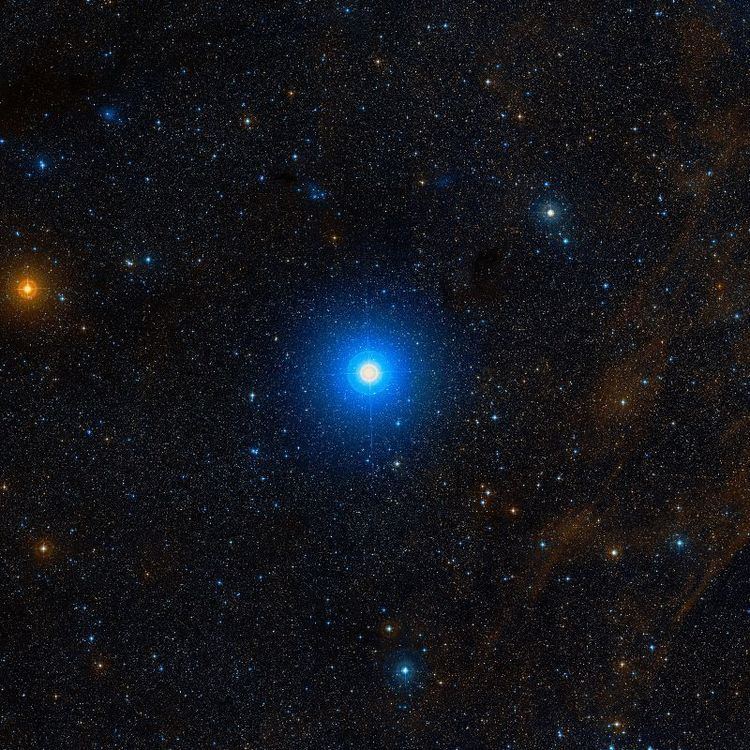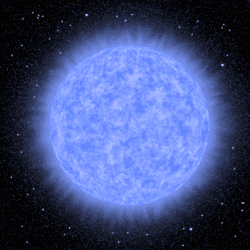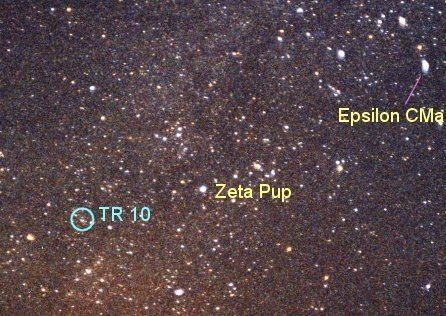Luminosity (bolometric) 550,000-800,000 L☉ Radius 9.744 million km (14 R☉) | Surface temperature 42,000 K Magnitude 2.21 Apparent magnitude (V) 2.21 | |
 | ||
Mass 4.475 × 10^31 kg (22.5 M☉) Similar Lambda Velorum, Gamma Velorum, Epsilon Carinae, Pi Puppis, Delta Canis Majoris | ||
Vagon brei zeta puppis
Zeta Puppis (ζ Puppis, abbreviated Zeta Pup, ζ Pup), also named Naos, is a star in the constellation of Puppis.
Contents
- Vagon brei zeta puppis
- Vagon brei last survivor of zeta puppis
- Nomenclature
- Namesake
- Physical characteristics
- Helium
- Origin
- References
The spectral class of O4 means this is one of the hottest, and most luminous, stars visible to the naked eye. It is one of the sky's few naked-eye class O-type stars as well as one of the closest to Earth. It is a blue supergiant, one of the most luminous stars in the Milky Way. Visually it is over 10,000 times brighter than the Sun, but its high temperature means that most of its radiation is in the ultraviolet and its bolometric luminosity is over 500,000 times that of the Sun. It is also the 62nd brightest star in terms of apparent magnitude from Earth.

Naos is typical of O-type stars in having an extremely strong stellar wind, measured at 2,500 km/s, which sees the star shed more than a millionth of its mass each year, or about 10 million times that shed by the Sun over a comparable time period.

Vagon brei last survivor of zeta puppis
Nomenclature
ζ Puppis (Latinised to Zeta Puppis) is the star's Bayer designation.

It also bears the traditional names Naos (/ˈneɪ.ɒs/, from the Greek ναύς "ship") and Suhail Hadar (سهيل هدار, possibly "roaring bright one") in Arabic. In 2016, the International Astronomical Union organized a Working Group on Star Names (WGSN) to catalogue and standardize proper names for stars. The WGSN approved the name Naos for this star on 21 August 2016 and it is now so entered in the IAU Catalog of Star Names.
Namesake
USS Naos (AK-105) was a United States Navy Crater class cargo ship named after the star.
Physical characteristics

Zeta Puppis has been extensively studied because of its rareness and relative closeness to Earth, but its physical parameters and distance are still poorly known. It should be a valuable step on the cosmic distance ladder, clarifying the distance of other high luminosity stars in the Milky Way galaxy and external galaxies.

The spectral type is O4If(n)p. O4 indicates a hot massive hydrogen-burning star, typically 40,000-44,000K. The "f" indicates that the spectrum has emission lines of ionised Helium and Nitrogen, not uncommon in somewhat evolved hot O stars and typically identified by the composite emission and absorption profile of the 468.6nm HeII spectral line. The "n" (for nebulous) indicates broadened absorption lines, caused by rapid rotation of the star, in this case over 220 km/s at the equator. The "p" is a general spectral indicator of peculiarity. This combination of spectral characters is unusual because evolved hot stars are expected to rotate relatively slowly after braking by a strong stellar wind, and only 8 stars of this type are known in the Milky Way. The spectral type complicates determination of physical parameters as the standard spectral luminosity indicator lines are peculiar and this type of star cannot be fully modelled. The enhanced Helium and Nitrogen and the lower surface gravity indicates some degree of evolution away from the zero age main sequence and Zeta Puppis is ranked as a supergiant.
The angular size of Zeta Puppis has been measured interferometrically to be 0.41 mas, and photometrically to be 0.38 mas. A known distance would directly give the actual size of the star, which would confine other characters such as luminosity and mass. Publications of the distance of Zeta Puppis vary from around 300pc based on dynamical measurements or parallax to over 600pc based on physical modelling. This leads to estimates of luminosity between 550,000 and 800,000 times the Sun, mass between 22.5 and 56 times the Sun, and radius between 14 and 26 times the Sun. The revised Hipparcos parallax value give a distance of 335 parsecs (1,093 ly) ± 4%, much lower than expected from the observed characteristics of the star.
Zeta Puppis has been reported to be variable and is classified as a suspected Alpha Cygni variable. It shows variations in Hα spectral line profiles and x-ray luminosity on timescales less than a day.
Helium
In 1896, Williamina Fleming observed mysterious spectral lines from Zeta Puppis, which fit the Rydberg formula if half-integers were used instead of whole integers. It was later found that these were due to ionized helium.
Origin
Early suggestions for the birthplace of Zeta Puppis were the very young Vela R2 stellar association at around 800pc and the Vela OB2 association at 450pc. Neither origin is satisfactory. A distance of 800pc requires an abnormally high luminosity, while the Vela OB2 association is much older than Zeta Puppis and the space velocity does not lead back to that cluster.
Many physical models and the original Hipparchos parallax measurements did lead to a distance value of around 450pc, but the revised Hipparchos reduction gave a much lower distance near 333pc. A recent dynamical study points to Zeta Puppis originating in the Trumpler 10 OB association at around 300pc, but this is also a much older cluster and physical models still lead to a distance of 450-600pc.
Zeta Puppis shows a high space velocity and very high rotation rate, and it has been speculated that it is a runaway star resulting from a supernova in a binary system, possibly the progenitor of the Gum Nebula but evidence supporting this is sparse.
